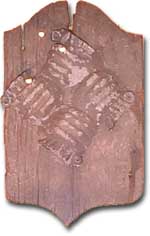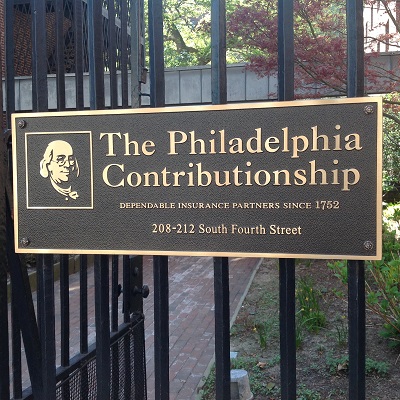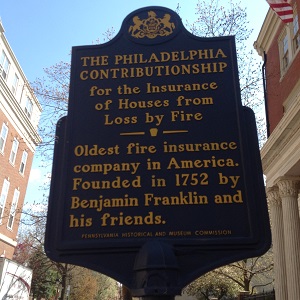

Insurance: Philadelphia Contributionship: Page 2
Founded by Franklin in 1752
Prudence coupled with providence have been hallmarks of The Contributionship.
Houses built not conforming to legal specifications were denied insurance. Mrs. Lydia Biddle, for instance, was denied insurance because of an unlawful wooden bakehouse adjoining her home. Early policyholders had to have a trap door to the roof as a way of fighting roof and chimney fires. During the British occupation of Philadelphia in 1777, a chimney sweep hired by the firm was sent around to occupied houses to maintain fireplaces. The lightning rod, invented by Director Ben Franklin, also helped to deter fires. Houses with trees in front of them were not insured because early hoses could not maneuver around them. This gave rise to a competitive company, the Mutual Assurance Company, which was better known as the Green Tree, which existed until 1997.
High-fire-risk businesses, such as apothecary shops and breweries, were either not given insurance or insured at significantly higher rates. Later, when skyscrapers were being built, the firm refused to insure them — and to this day, still don't. They do insure high-rise condominiums providing there is adequate firefighting equipment that can reach the insured space. Their judgment proved sound when the earliest Philadelphia skyscraper, the Jayne Building, housing pharmaceutical supplies, had a crippling fire that destroyed its top floors.
The Contributionship was fortunate in 1752, its first year, in that 143 policies were written and not one fire was recorded. In 1753, a house on Water Street became the first insured property to burn. Damage was great, but Franklin was happy to report in the Gazette that damages were to be immediately repaired without cost to the owner. Cost for repair totaled 154 pounds, nearly a third of the Society's assets. Each member had five shillings threepence per pound of deposit deducted to pay for the fire.
Over time The Contributionship's assets grew and they invested their money in various ways. They wrote mortgages and invested in stocks and bonds. They donated money to the volunteer fire companies who responded to structures insured by The Contributionship. Though volunteer fire brigades responded to all fires, they had more compelling reason to fight fires at buildings bearing The Contributionship's hand-in-hand fire mark. These fire marks served several functions. They indicated to fire companies that The Contributionship would reward them for a job well done. Often, firefighters were members of The Contributionship. The less damage to a building, the less deducted from their own premiums. However, if a house was uninsured, the fire would be put out regardless, despite what some modern historians and interpreters may claim. In any case, fire brigades would usually bill the uninsured householder or an insurance company with properties nearby to seek payment for their fine work in battling the blaze.
Philadelphians were keenly aware that the growing city's economic well-being rested in the well-being of its citizenry. Allowing buildings to burn, perhaps spreading into larger fires, made no sense. Philadelphia understood even then the interconnectivity of its infrastructure and its economic health. When one citizen suffered, all suffered.
The Museum
This building was erected in 1836 as home to The Contributionship, which previously operated out of various houses and taverns. Today, the building is used as their headquarters and contains a small but compelling museum presenting a fascinating collection of memorabilia. There are fire marks, firemen's hats, miniature engines, lanterns, and other accoutrements. A silver "speaking trumpet" once used to tantara orders at confused fire sites is among the more interesting artifacts because of its rarity. A fiery eagle clutching a hand-in-hand fire mark and an American flag carved by Collins West catches the visitor's eye. Fascinating, too, is a survey of Carpenters' Hall made in 1773. You will also find surveys for the homes of John Penn (William Penn's son) and Benjamin Franklin.

A seating plan on the wall names the holders of the twelve Directors' seats since The Contributionship's inception. Across the hall is a room which might be called a double parlor in which the company holds its meetings. The grand table designed by William Russell in 1892 is noteworthy. This space formerly housed the treasurer's family's two bedrooms. Note the especially fine marble fireplaces and gilt mirrors. Crystal candelabra and cachepots enhance the scene. Fine portraits of past Directors stare back at us. Their conservative countenances joined with the timeless strength of the room evince a strong company nearly 250 years old, confident in its future.
While on the second floor the visitor can play a "Where's Waldo" game looking for the hand-in-hand fire marks instead of Waldo. They are to be seen everywhere, from fireplaces to sideboard — there are at least a dozen. The sideboard was designed by Michael Deginther.

In addition to supplying the insurance needs of Philadelphians for nearly 250 years, The Contributionship has of late provided another valuable service. Society Hill, the neighborhood of which The Contributionship is a part, has over the last 40 years been transformed like the proverbial phoenix. Once, one of the city's most delapidated areas, the neighborhood now contains more than 600 renovated houses and more 18th-century architecture than anywhere else in the entire country. The Philadelphia Redevelopment Authority acquired many deteriorated properties in the neighborhood and sold them to private individuals with the agreement that the houses would be restored. As many of these houses looked nothing like they did originally, some owners had to use past Contributionship insurance surveys and records to aid them in recreating floor plans and engineering features of these properties.
*Many of the buildings you visit on the Tour of Historic Philadelphia and are now, or have once been, insured by The Contributionship. They include Pennsylvania Hospital, Christ Church, Old Pine Street Church, the Powel House, Carpenters' Hall, Society Hill Synagogue (when it was the Spruce Street Baptist Church), and, naturally, Benjamin Franklin's 1766 house on Market Street. Any virtual visitors with an interest in insurance or firefighting are urged to read Nicholas B. Wainwright's A Philadelphia Story — The Philadelphia Contributionship for the Insurance of Houses from Loss by Fire, from which much information on this page was found.




